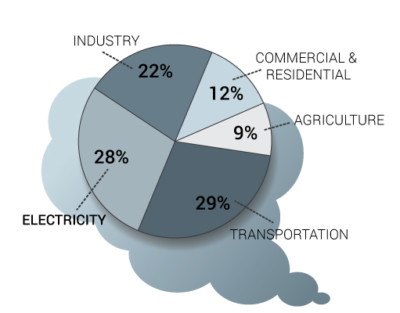Data Doesn't Lie
Almost everything in our daily lives revolves around something that is powered: computing devices & peripheral equipment, transportation, communication, appliances, heating & cooling. Many school populations bursting at the seams, the result is a need for more power. How can we make less of an impact on traditional energy resources while continuing to function in a technology-driven society and also cut expenses?
SolarWalk is dedicated to helping schools and not-for-profits find these energy efficient solutions.
According to the U.S. Energy Information Administration (EIA), more than 5 million metric tons of Carbon Dioxide emissions were produced in America in 2017. About 34% of that (or 1,744 million metric tons) was a result of electrical power generation.
We are a technology-driven society and energy-efficient products have helped reduce some of the draw on our power supply. From February 2018 to February 2019, there was a total net generation of 313,278 (thousand mWh)–up 2.3% from the prior year’s consumption.1
Actually the national average of electricity costs has increased dramatically since 1997 (a 22-year period)–more than 55%, according to EIA data.2
A SolarWalk solar power system can save you almost 60% on electric bills over a 25-year period. Contact us to learn how.
Modern Energy Terminology

Carbon Footprint is an estimate of the total amount of greenhouse gases produced to operate a product/home/business—which includes our daily travel, the food we eat, the amount and type of electricity we use, etc. There are online calculators to help determine an individual’s or business’ carbon footprint, but it’s not exactly accurate because often the goods and services purchased as well as the emissions produced by family members, staff or outside vendors aren’t included in the calculations. So essentially the goal is for each of us to try and reduce our draw on the production and burning of fossil fuels.

The Environmetal Protection Agency (EPA) calculated that in 2017 the second largest source of GHG emissions in the U.S. was from electricity production (following transportation, which was only 1% higher); approximately 63% of America’s electricity is generated from burning fossil fuels such as coal, oil and natural gas.4
Non-fossil sources of electricity (such as nuclear, solar, hydroelectric and wind) are non-carbon emitting.

In 2015, electricity production was the number one source of GHG emissions, so with the rise of non-fossil/renewable sources of power, we should see electricity’s GHG emissions continue a downward trend.
Solar Makes Sense
Between the 1950s-70s, scientists began to explore other sources of power based on the continued growth of the global population and the realization that fossil fuel resources will be depleted at some point.
By the 21st century environmental damage as well as energy security and economic stability in regions such as the Middle East and Russia spurred further research to find alternative power solutions. 5
In the past few years, renewable power sources have been incentivized with tax credits and net metering. Installation costs have also dropped significantly, which has helped the industry to reach into more widespread markets. Some states have actually implemented mandatory renewable energy standards. All of this growing solar activity has begun to show positive results. According to Solar Energy Industries Association’s (SEIA) 2019 article, electricity generated by the sun offsets more than 73 million metric tons of CO2 emissions each year.6
SolarWalk is poised to develop solar carport, ground mount and rooftop solutions for school campuses and nonprofits that will set up reliable, sustainable electricity generation for years to come. No organization funds are needed for maintenance, and you only pay for the power you use.
Your SolarWalk commitment means you are locked in to stable rates that don’t fluctuate with inflation for the next 25 years. So your savings will continue to grow. And with the carports you get some covered parking too!
Resources
1EIA: Net electricity generation
2EIA: Electrical cost comparison/data
3NASA: Greenhouse gases
4EPA: Greenhouse gas emissions data
5Environmental Science: Beginnings of alternative power sources
6Solar Energy Industries Association: Renewable energy data
